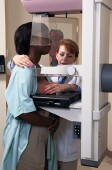
THURSDAY, May 2 (HealthDay News) — Women who have a breast biopsy that turns out to be benign are typically told to undergo another imaging test, such as a mammogram, in six to 12 months. Now, a new study suggests that the longer interval might be better.
Researchers who followed women who had benign breast biopsies say having that test less than a year later finds few cancers and is a drain on health care dollars.
”Doing a follow-up imaging study six months after a benign needle breast biopsy has a low likelihood of finding breast cancer at the biopsy site,” said study author Dr. Andrea Barrio, an attending breast surgeon at Bryn Mawr Hospital, in Pennsylvania.
Most of these women, she said, can wait longer than six months before repeating the mammogram, ultrasound or MRI.
Dr. Demitra Manjoros, a breast fellow at Bryn Mawr, is due to present the research Thursday at the American Society of Breast Surgeons’ annual meeting, in Chicago.
A biopsy is done after an abnormality is found on an imaging test such as a mammogram. The standard of care is to perform an image-guided needle biopsy, Barrio said.
“However, when you do a needle biopsy, you only sample the lesion or abnormality, instead of removing it,” she said.
So, the follow-up imaging was suggested. Under current National Comprehensive Cancer Network guidelines, the repeat imaging is recommended six to 12 months after a benign breast biopsy.
“In my practice, I perceived that this short-term imaging did not seem to add anything to the care of the patient,” Barrio said.
So, she launched the study, focusing on 337 women who had benign biopsies and met one other criterion: Their pathologic findings explained the finding on the image. Researchers then looked to see if the interval for repeat imaging made a difference in finding cancer.
Of the 337 women, 169 had imaging repeated less than 12 months after their benign biopsy result. Another 101 had no documented imaging test repeated. And another 67 had repeat imaging 12 months or later after the biopsy.
Of the 169, just one breast cancer was identified. Of the 67 who had repeat imaging at 12 months, no malignancies were found.
The cost of detecting a missing cancer with the shorter interval follow-up was nearly $193,000 in this group.
The study findings support a policy of discontinuing repeat testing less than 12 months after such a benign finding, Barrio said.
The findings don’t mean no one should have shorter-term imaging follow up, Barrio said. While in general, routine short-term repeat imaging after such a benign biopsy is not needed, she said, “I’m not saying nobody should do it.”
“Certain women would require six months follow-up,” she said. For instance, a woman whose initial imaging findings were vague or not specific might be advised to get repeat imaging in less than a year, she said.
A breast cancer expert commented on the new research.
The study is sound, said Dr. Laura Kruper, director of the Cooper Finkel Women’s Health Center and co-director of the breast cancer program at the City of Hope Comprehensive Cancer Center in Duarte, Calif.
“I think most women would be fine having repeat imaging in 12 months,” she said, “but it should be done on a selective basis.” A doctor must take the whole patient into account, she said, weighing such factors as family history and a woman’s views of the testing intervals.
“There are some patients who are going to be so nervous waiting a year,” Kruper said.
The data and conclusions of research presented at medical meetings should be viewed as preliminary until published in a peer-reviewed journal.
More information
To learn more about a breast biopsy, visit the American Cancer Society.

